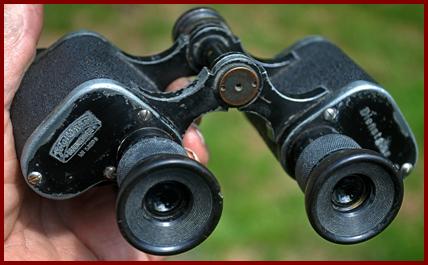|
Exercito Brasileiro Army of Brazil D.F Vasconcellos Industria Brasileira Pioneiro 6x30 Military Binoculars made in Brazil |
|
As WWII mobilization contracts preempted the exportation and supply of military optics from traditional suppliers like Germany, the UK, and the USA (for the second time in 40 years), other countries viewed developing a domestic military optics industry as being in the nation’s strategic interest (Just as Japan had done immediately after WWI). D.F. Vasconcellos Industria Brasiliera was founded in Sao Paulo Brazil in April 1941, and it’s first decade was devoted exclusively to producing military optics, such as my 6x30 Brazilian Army marked binoculars in it’s DFV and Exercito Braziliero marked case. After 1951 D.F. Vasconcellos added civilian optics, and then in 1962 they branched into surgical microscopes, and now they specialize in microsurgery optical instrumentation. The “ A ” and flaming bomb presumably indicates ordnance (artillery) division intended usage. |
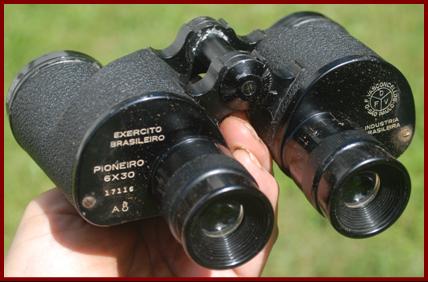
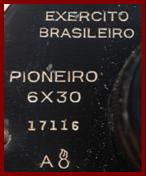
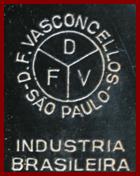


|
Czech Optikotechna P ŕ erov 8x30 Military Binoculars with Reticule |
|
My 8x30 military binoculars carry the OP logo of Optikotechna P ŕ erov. Since this firm was nationalized in 1946, and according to a 2010 Meopta presentation it was renamed Meopta in 1946, I believe these binoculars must predate 1946. I believe 670 was their model number for 8x30 binoculars with reticule/ ranging grid. Optikotechna P ŕ erov was founded in 1933, and then became a subsidiary of Zbrojovka Brno in 1935, and was a major supplier to the Czech army and a supplier to other armies (including Sweden) After 1939 the company produced only military optics, including binoculars, ZF4 rifle scopes, periscopes, & range finders. It was then under German control during the occupation of Czechoslovakia, so WWII Optikotechna binoculars produced after 1943 for Germany in German occupation would have carried only the d.o.w. German wartime mfgr code. |
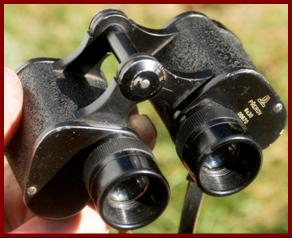
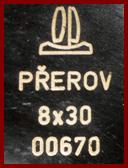
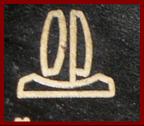
|
“OP” logo |
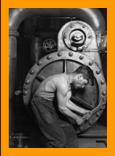

|
Japanese External Reverse Porro Prism Binoculars. WEBSITE MUSEUM |
|
OTHER BINOCULARS #9 & OPTICAL SIGHTS (MOSTLY MILITARY) |
|
Ex é rcito Brasileiro Army of Brazil Czech made Optikotechna P ŕ erov 8x30 Military Binoculars made in Czechoslovakia. |
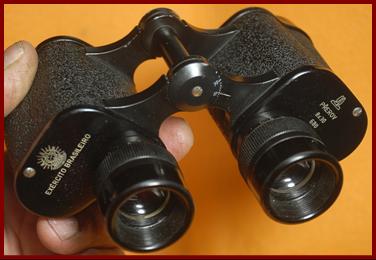


|
My 8x30 Brazilian Army / Ex ér cito Brasileiro military binoculars carry the OP logo of the Czech optical firm Optikotechna P ŕ erov. Given WWII German occupation, and firm nationalization in 1946, and also according to a 2010 Meopta presentation it was renamed Meopta in 1946, I believe these binoculars must predate 1943. I believe that 680 is their model number for 8x30 binoculars without reticule/ ra n ging grid, and not a serial or property number. More information on Optikotechna P ŕ evov binoculars appears with the binoculars below. |
|
Strange and Unusual ! Carl Zeiss Jena Binoct ?? Perhaps Marketing sample 7x50 binoculars |
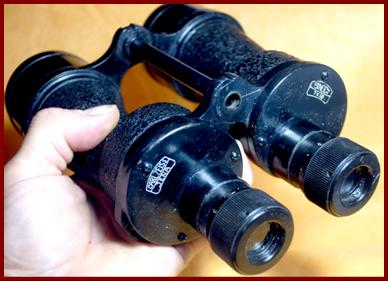
|
When I encounter a product that appears factory produced but whose configuration & markings are inconsistent with known production, I think marketing prototype. The reason that I think this is that as a former product engineer, product line director, marketing director, marketing VP, and sales rep at 4 companies I probably had 100 examples of non standard product (prototypes and mockups ) made for me with non standard designs, colors, features, markings, logos, and also had existing products re-branded: and their purpose was to measure distributor/market demand at trade shows; as samples for potential contracts; for field trials; as sales samples, etc.: of items which did and did not proceed to production. And I probably watched colleagues have 1,000 prototypes made. Real example: I had a meeting with the head of the NY State Prison system with a prototype, and then ran a successful field trial of 2 functional prototype body orifice contraband metal detecting chairs as proposed prison equipment at two New York state prisons. And then New York, Ct., and other state and federal prison systems purchased them for their maximum and medium security prisons. I still have those two prototypes. If someone looked at them they might say “the co. never made them that way”, because those two trial prototypes differed in ways to the production models. They were factory made, factory marked, functional, but not standard production: only field trial prototypes. For every product ever manufactured, various prototypes were made, plus prototypes and mockups were also made for millions of products being considered for marketing/production. Every trade show was filled with them. Most were destroyed later as junk, but some just get taken home, like I sometimes did. When I had prototypes made, they did not normally get a serial number because they were not part of a production, except when mandated by law (firearms), which like military contract guns would get a different serial number from regular production. I have a collection of prototypes including stuff I wasn’t involved in, including one of the world’s larger collection of factory made salesman sample cut away padlocks and locks. My point is that for me Zeiss markings and a seemingly unknown Zeiss product name (“Binoct”) on Ross or NIL No 4 or No 5 pattern binoculars (a Steplux variation), with no serial number (both Zeiss and Ross/NIL always had serial numbers) and with no sign of ever having had any other markings, to me suggests being a prototype made at some factory. I know that when WWII ended Ross was desperate to find sales markets, but the only country whose consumers had lots of disposable income and big demand for binoculars was the USA. But there was no consumer market demand in the USA for Ross brand binoculars. But the US government had widely advertised during the war that they needed Zeiss binoculars to be donated to the US military, and they were one of the most desired soldier bring back items, so everybody knew Zeiss binoculars were desirable. The idea of Carl Zeiss Inc (independent US importer) or another importer/distributor exploring the feasibility of Zeiss branded Ross/NIL binoculars for the wealthy and binoculars hungry post war US market seems a perfectly logical probability to me, but it is just educated conjecture that I cannot document. |

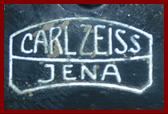
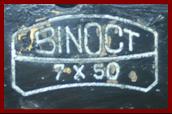
|
Zeiss marked binoculars are on the left side. Naval pattern (added red naval desiccation ports) Ross No 5 Mk 4 binoculars are on the right. |
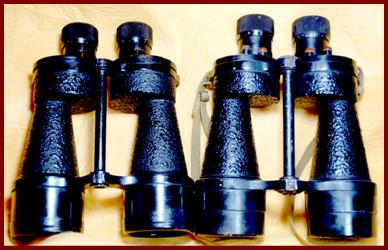
|
In support of my speculation (these being a Zeiss branded Ross factory made importer sample and not an end user fake) and contrary to what one might suppose, in the immediate post war period neither of the two surviving Zeiss named entities (in East & West Germany and with both making Zeiss logo marked binoculars) apparently had any trademark rights to Zeiss name/ Zeiss logo use on binoculars. The West German Zeiss entity apparently obtained a West German trademark 641728 registered June 20 1953 for West Germany. The West German Zeiss entity applied for a US trademark (for “Carl Zeiss” plus rectangle or segmented rectangle with one or more curved sides) on Dec 10,1953 in the USA (but did not make any claim of any priority date activity in US commerce for prior to 12/10/53), and it appears their trademark registration was not granted until Oct. 5 1971/ #0921537. The West German Zeiss entity obtained a “Carl Zeiss Jena” logo design as a UK trademark registered May 20,1971/#975176). So I believe both Zeiss and non Zeiss affiliated entities had a legal right to have manufactured/imported/marketed a Zeiss logo but non Zeiss associated binocular, as my Carl Zeiss Ross binoculars may be a sample of, in the US prior to 1953, and probably in the US and the UK up to 1971. Separately, there is evidence that various importers had non Zeiss manufactured Zeiss marked binoculars made, but those looked as much like Zeiss models as possible, with Zeiss logos and with the standard Zeiss model names on them, because the intent was certainly intended to deceive customers with them. And apparently Zeiss at one point had binoculars contract made in Japan, widely proclaimed as being fake Zeiss binoculars, until evidence apparently surfaced that they were actually contracted for by Zeiss. |
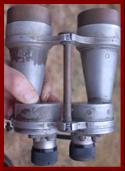
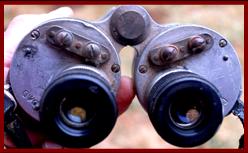
|
NIL Nottingham Ind Ltd naval binoculars |
|
Jules Huet & Cie 16x40 British Military marked binoculars documented first sold in Argentina |
|
My Jules Huet & Cie. 16x40 binoculars are marked as originally having been sold at retail by the optical shop G. Catton Optico , 531 C .(Calle) Pellegrini, Buenos Aires (Argentina). (This firm is documented as a seller of optical goods in the 1914 United States Bureau of Foreign & Domestic Commerce Directory). These binoculars are also British War Office broad arrow property marked, This is not actually an ownership contradiction, as in WWI and WWII in order to meet military binoculars shortages, the UK widely solicited donation of decent civilian binoculars, which if accepted into military service, would have received government property markings such as these. |
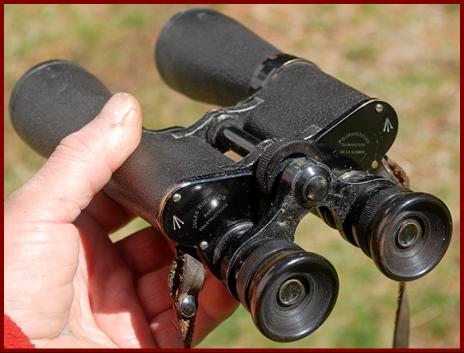
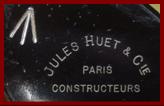
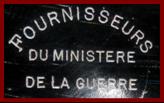


|
“Suppliers to the ministry of war” logo. |
|
1944 WWII Indian army No. 2 Mk. II x6 binoculars made by IndianOrdnance Factory in Calcutta |
|
North Korean 8x30 army KPA/ Korean Peoples Army 8x30 binoculars made in North Korea DPRK/ Democratic Peoples Republic of Korea |
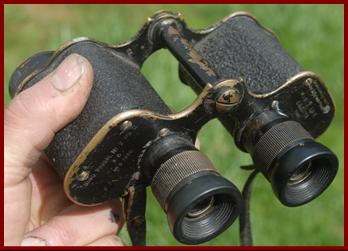

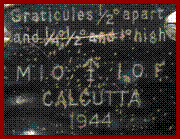
|
It is my understanding that the Mathematical Instrument Office ( M.I.O. ) established the Indian Ordnance Factory ( I.O.F ) in Calcutta India in 1941 to produce Artillery directors, binoculars, and prismatic compasses. And from April 1941-August 1945 the I.O.F. `produced 17,724 No 2 6x30 binoculars, including my 1944 example. The broad arrow over “ I ” is the Indian government property mark. (Information credits Frank Flagorio, William Reid). The S arrow S is not proven, but is plausibly an Indian Signals Squadron marking (speculative). |
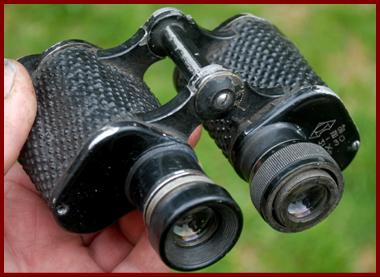
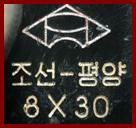
|
The Google Translate Ap on my phone interprets this as “Chosun Pyongyang” under the factory logo. Additional info sought? Miniature.binoculars@ gmail.com. |
|
It impressed me that my North Korean KPA/ Korean Peoples Army 8x30 binoculars were obviously designed for easy field servicing: they were probably one of the easiest to disassemble and work on of any full size binoculars I have encountered. (I had to clean and recollimate mine). I believe my binoculars post date the Korean war/ post 1953. I have found little public information on North Korean optical industries, and would welcome further insights that viewers might be able to provide to miniature.binoculars@gmail.com. |
|
W.S.L.D.V. West Sussex Local Defence Volunteers marked Magnus 12x30 binoculars marked to commander Leslie Evershed-Martin of #5 company C platoon 1st battalion/Chichester Home Guard |
|
The Chichester Home Guard was formed in the summer of 1940 as part of the West Sussex (UK)Local Defense Volunteers to counter a threatened German invasion, and emplaced 2 howitzers aimed at Thorney Island. My Magnus 12x30 private purchase binoculars and case are marked W.S.L.D.V. for W est S ussex D efense V olunteers and are engraved EVERSHED-MARTIN CHICHESTER for Leslie Evershed Martin (OBE, CBE), commander of 5 company C platoon 1st Batalion W.S.L.D.V. /Chichester Home Guard. Leslie Evershed Martin went on to become mayor of Chichester and founded the Chichester Festival Theater. Info credit: A to Z Chichester by Phillip MacDougall |
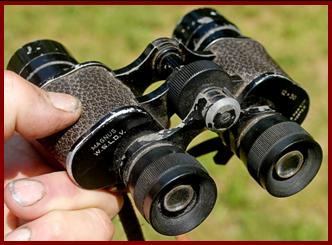


|
North Korean manufactured North Vietnamese Army Quân đội Bắc Việt 8x30 military binoculars |
|
I believe that my 8x30 binoculars marked in Korean as “binoculars’ (model?) “73” are an example of North Korean manufactured binoculars supplied to NVA/ North Vietnamese Army troops ( Quân đội Bắc Việt ) during the North/South Vietnam/ US conflict. |
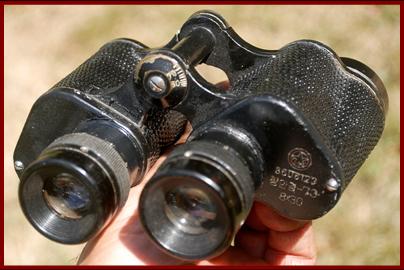
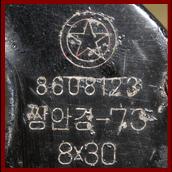

|
FOR GERMAN WWII BINOCULAR and OPTICAL MANUFACTURER CODES |

|
1944 U.S. Navy UniversalCamera Corp. BU Ships Mark 33 Mod. 1 6x30 Military Binoculars |
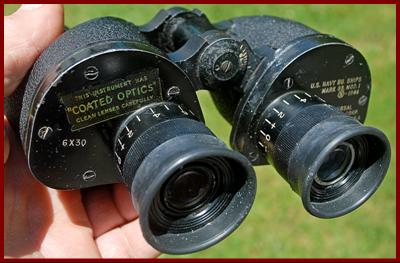
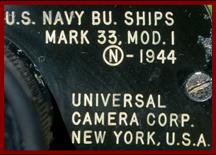
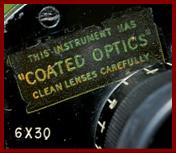
|
My U.S. Navy Mark 33 Mod. 1 6x30 binoculars were produced in 1944 by the Universal Camera Corp. of New York City, by authority of the U.S. Navy Bureau of ships, created on June 20,1940, in effect consolidating many aspects of design and procurement under the new organization. Universal Camera Corp. was founded in 1932 by two businessmen (Shapiro and Githens) who had no previous optics experience, and who produced 37 cent low end mass market cameras from a stolen design (per University of Indiana) |
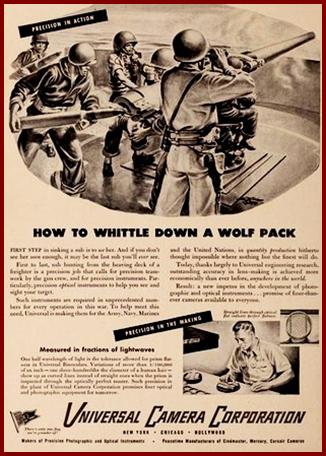
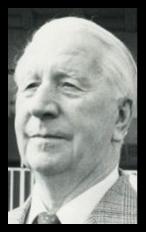
|
Leslie Evershed Martin |


|
(first example) Establts AFSA Serie 6 French Military binoculars MG/ Minist è re de la Guerre marked, but that are also UK military broad Arrow property Marked. |
|
AFSA was a supplier of French military equipment including binoculars circa WWI, and documentation does exist that AFSA binoculars were also sold to the US and UK military in WWI (the US military/ Franford Arsenal disposed of 2,754 pairs of Afsa binoculars as military surplus in 1921). My Establissments Afsa serie 6 binoculars carry the MG French Minist è re de la Guerre property mark, and they also carry the British Broad Arrow property mark. The UK military did property mark and issue both contract purchases and used non standard binoculars they acquired as military property, including those acquired by private donation in WWII, and to some degree in WWI, as substitute standard due to the shortage of standard binoculars. And also during both wars, some contracted property marked military binoculars were diverted among allies, if surplus to issue, and/ or in exchange for more valued armaments. An attempt has been made to scratch out the serial identity S.2 2102, typical on absconded military equipment. The case is broad arrow marked and is also subsequent owner named. |

|
1912 Annuaire Officiel des Officers de l’arme é active |
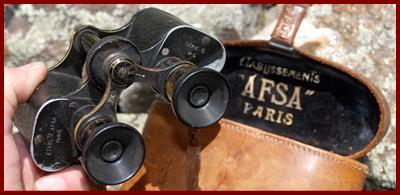


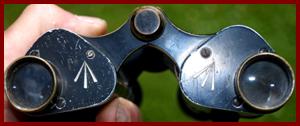
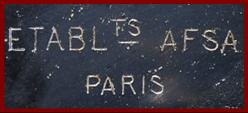


|
(second example) Establts AFSA Serie 6 French Military binoculars MG/ Minist è re de la Guerre marked, but that are also UK military broad Arrow property Marked. |
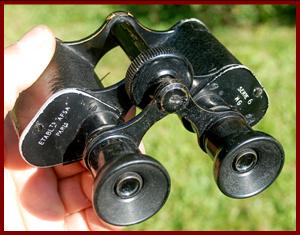
|
My second pair of Establissments Afsa serie 6 binoculars carry the MG French Minist è re de la Guerre property mark, and they also carry the British Broad Arrow property mark. The two pairs suggest that there was a Minist è re de la Guerre and UK ministry of defense coordinated equipment supply transfer. |


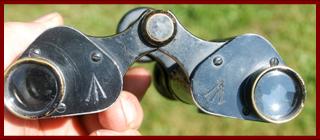
|
Fabryka Aparatur Optycznych I Precyzyinch H. Kolberg iSka S.A. (Factory of Optical & Precise Instruments H. Kolberg Ltd) was established in Poland in 1921, and my 6x30 binoculars were part of a 1925 4,000 Polish military 6x30 binoculars contract which funded manufacturing equipment purchases to establish the factory. My 6x30 binoculars carry the WP Wojsko Polskie/ Polish Army mark, plus Polish eagle, and by serial number #10667 they were produced in 1927. Info credit : “The History of 6x30 binoculars H. Kolberg iSka and PZO” by Anna Vacani. |
|
1927 Polish H. Kolberg iSka 6x30 WP (Wojsko Polskie/Polish Army) Military Binoculars w/ graticule |
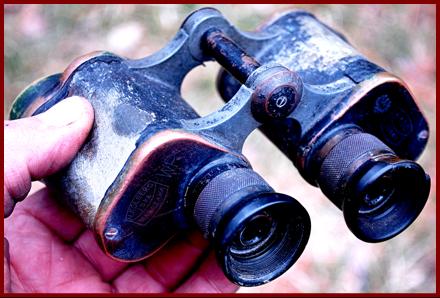


|
During WWII Universal Camera company produced around $6 million of binoculars, with production exceeding 11,000 binoculars a month by 1943 for the USA and Great Britain. Universal Camera Corp. became insolvent in 1952, and closed in 1964. |

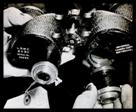

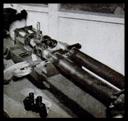
|
1944 Universal factory binocular lens/prism grinding/coating |
|
1944 Universal factory binocular assembly |



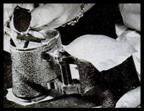

|
1944 Universal Camera Corporation Advertisement |
|
North Vietnamese army logo |
|
भारतीय सेना की सैन्य दूरबीन |
|
NON MINIATURE BINOCULARS AND OPTICS: MOSTLY MILITARY |
|
Lemaire Lumineuse French made 8x military binoculars with graticule/ range grid, MG marked |
|
The Beille Lemaire firm was primarily known for Lemaire non prismatic galilian opera and field glasses, but also produced some civilian prismatic binoculars, and prismatic military binoculars with graticules, such as my 8x military Lumineuse binoculars with right ocular graticule, which has an unusual graticule leveling lever. It is MG marked as being property of the French Minist è re de la Guerre/ Ministry of War. |
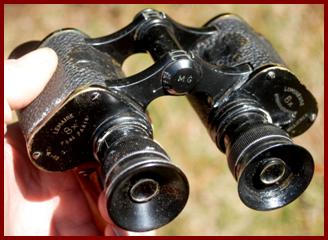

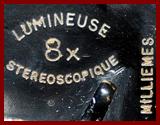
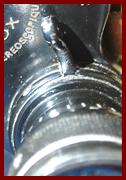


|
WWII Hungarian Army L å tcs ö 6x30 AM.KIR.KINGSTAR TULAJDONA Royal Hungarian Military Binoculars serial number 47806 with graticule/ ranging grid |
|
I believe my L å tcs ö 6x30 binoculars to be Hungarian WWII military issue and their marking “ AM.KIR.KINGSTAR TULAJDONA ”’ to be the equivalent to “Property of Royal Hungarian Treasury”. These binoculars have both horizontal and vertical ranging grids, and may be either an artillery or infantry model. I have seen identical binoculars marked as “L é g ó ”, “Honvedseg”, or Suss/MOM (Magyar Optikai Muvek), with most of those dated 1941, suggesting multiple manufacturers providing this pattern of binoculars to supply the WWII related Hungarian military mobilizations. |
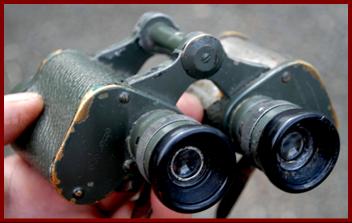
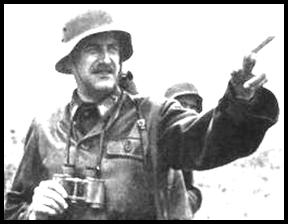


|
Hungarian officer in WWII |
|
Post WWII Hungarian Army 8x30 HONV É DS É TULAJDONA (Property Hungarian Army) Military Binoculars serial number 919263 with graticule/ ranging grid |
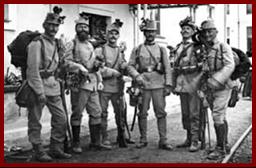
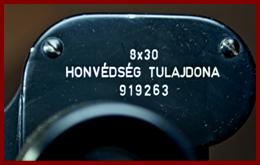
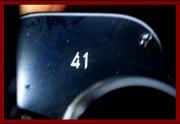
|
I believe my HONV É DS É TULAJDONA ( property Hungarian army) marked military binoculars with graticule to be manufactured in the late 1950’s or in the 1960’s, based on the earlier binoculars pattern adopted in 1941. |
|
Post WWII Hungarian Workers Guard 8x30 MUNKASORSEG TULAJDONA (Property Workers Guard) param ilitary Binoculars serial number 874516 with graticule/ ranging grid |
|
The MUNKASORSEG TULAJDONA or Workers Guard existed 1957-1989, as a part time armed paramilitary extension of the Hungarian Socialist workers party. My guard binoculars are identical to my Hungarian Army binoculars above, except for the property mark. With yellow filters and graticule/ ranging grid. |

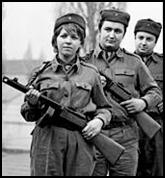
|
MUNKASORSEG |
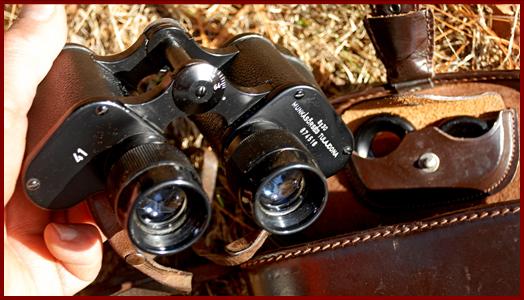

![Text Box: CLICK ON PAGE LINE. CLIQUEZ SUR LA LIGNE DE PAGE. KLICKEN SIE AUF SEITENZEILE. HAGA CLIC EN LÍNEA DE PÁGINA..[ページ行]をクリックします。НАЖМИТЕ НА СТРОКУ СТРАНИЦЫ. ALSO SEE INDEX.](image3473.gif)
|
1979 Avimo L12A1 7x42 British Army fixed focus Military Binoculars |
|
My L12A1 7x42 fixed focus rubber armored British Military binoculars were produced in 1979 by Avimo Ltd. of Taunton UK (which had been acquired in 1971 by optics supplier United Scientific Holdings, later renamed Thales Opticsh). They have a left ocular horizontal ranging grid and rubber eyecups designed to be compatible with eyeglasses or gas masks, and they have attached ocular covers, and filters, but no objective covers. They are fixed focus. These type military binoculars was used in the Falklands conflict of 1982, and in the Iraq and Afghan wars, so they are a compatible accessory for my 1966 109 military land rover ambulance and 1977 military land rover artillery tractor (both used in the Iraq War) and my ex Northern Ireland Snatch 1.5 CAV Armored 110 Land Rover that patrolled in Basra Iraq 2004-2007. it is nice when collections overlap. These binoculars have an odd non intuitive pivot geometry. |
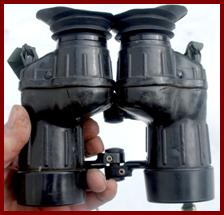
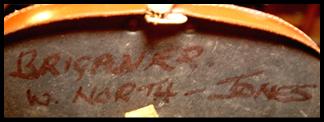
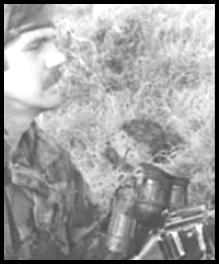

|
British Soldier in the Falklands war with Avimo L12A1 binoculars |

